Subscribe now to get notified about IU Jharkhand journal updates!
Organizational Capital as an antecedent to CRM Technology use : A study of the pharmaceutical sector in India
Abstract :
Customer Relationship Management has been researched extensively in past decade and there are ample evidence that it improves the organizational peformance in terms of customer retention, customer satisfaction, and customer value development. However, not every organization has been able to use the technology associated with CRM and due to this lack of proper usage of CRM systems, poor performances have slo been reported. One of the ways to facilitate the use of CRM technology in an organization could be to support the CRM implementation with proper employee training, customer relationship orientation, support from top management, and improved organizational incentive and reward system. All these factors are summed up in a multidimensional construct i.e., Organizational Capital. This paper examines the importance of Organizational Capital as an antecedant of CRM technology use. The results of this study depict that Organizational Capital positively influence the CRM technology use in an organization and thus is a antecedant to CRM technology use. Further, the implications for managers are also presented.
Keywords :
Customer Relationship, CRM technology, Organizational incentive, Organizational Capital.Introduction :
In recent years, researchers and academicians have tried to identify antecedents and consequences on overall CRM performance. Except a few studies (e.g.Chang, Park, &Chaiy, 2010), there is a scarcity of studies that have tried to look into the antecedents of the actual usage and variety of CRM technology in an organization. The extant literature on antecedents mainly comes from the TAM (Technology Acceptance Model). But, there are several other factors that could contribute to the better usage and implementation of CRM technology and Organizational Capital seems to be one of them. Consequently the main objective of this study is to examine the impact of Organizational Capital on the CRM Technology use.
Literature Review and Conceptual Framework
One of the primary motive for the study is that there are a
little evidence indicating satisfactory performance from
CRM implementation and this may be attributed to the
fact that such implementations are done without the
appropriate organizational transformations (Hunter &
Perreault Jr, 2007) and it may be also due to lack of
understanding about CRM (Payne and Frow, 2005). The
top management support, proper training of employees
and suitable changes in organizational reward systems are
the organizational changes that can help in achieving
successful CRM outcomes and these transformations are
usually evident in the belief and value systems of the
organization (Boulding et al. 2005; Payne & Frow 2005).
Some studies in recent past may have included the top
management support, reward systems, and employee
training as the possible predictors of the CRM technology
use; however one of the important dimensions that hold
its importance in this regard is Customer Relationship
Orientation. Though it is not quite different but it differs
from the other dimensions with respect to the approach
and attitude depicted by organizations when it comes to
handling the customer relationships. Thus it has been
added to the Organizational Capital construct to further
understand its peculiarities in an emerging market. Also,
the research related to Customer relationship Orientation
in the relationship marketing literature is very sparse. It
reflects the belief and attitude of the organization towards
the importance of the customer relationships. In other
words training and rewards are practical oriented
organizational transformations whereas CRO is an
enduring policy that is latent and should always be
present in an organization. Investing in high cost CRM
technology without having a customer oriented culture is
a mere waste of financial resources (Ryals & Knox, 2001).
The Customer Relationship Orientation as a belief system
emphasizes the importance of customer relationships and
thus motivates the organizations to deploy precious
resources to attain this objective, thus it acts as a guiding
force in successful implementation and use of CRM
technology use (Day, 2003). Since investment in CRM
technology use done to enhance the customer
relationship, it can be suggested that Customer
Relationship Orientation could be a potential antecedent
to CRM technology implementation (Jayachandran,
Sharma, Kaufman & Raman, 2005) and thus the current
study postulates that organizations which are highly
oriented towards the customer relationships and focus 62
more on their customer relationships than their functional
aspects are more likely to invest in CRM technology use on
a larger scale. Therefore, based on this belief that
Organizational Capital as a whole can significantly
contribute towards the successful implementation of CRM
Technology use and consequently aid in enhancing the
firm performance it is hypothesized that:
H1 : The Organizational Capital positively associated with
the use of CRM technology use.
Primary research hypothesis with respect to antecedents of
CRM technology use intends to examine the impact of
Organizational Capital on CRM Technology use as a
whole. In order to know the individual impact of each subconstruct
of Organizational Capital on the CRM
Technology use sub-hypothesis were developed and the
conceptual framework is presented in figure 1. . Testing of
these hypotheses will provide deeper insights with respect
to the individual effect of these components on CRM
Technology use and whether all of them are significant at
their individual level or not. Based on this idea following
sub-hypothesis have been developed.
H2 : Employee training is positively associated with the
use of CRM applications.
H3 : Customer centric management system management is
positively associated with the use of CRM applications.
H4 : Customer Relationship Orientation is positively
associated with the use of CRM
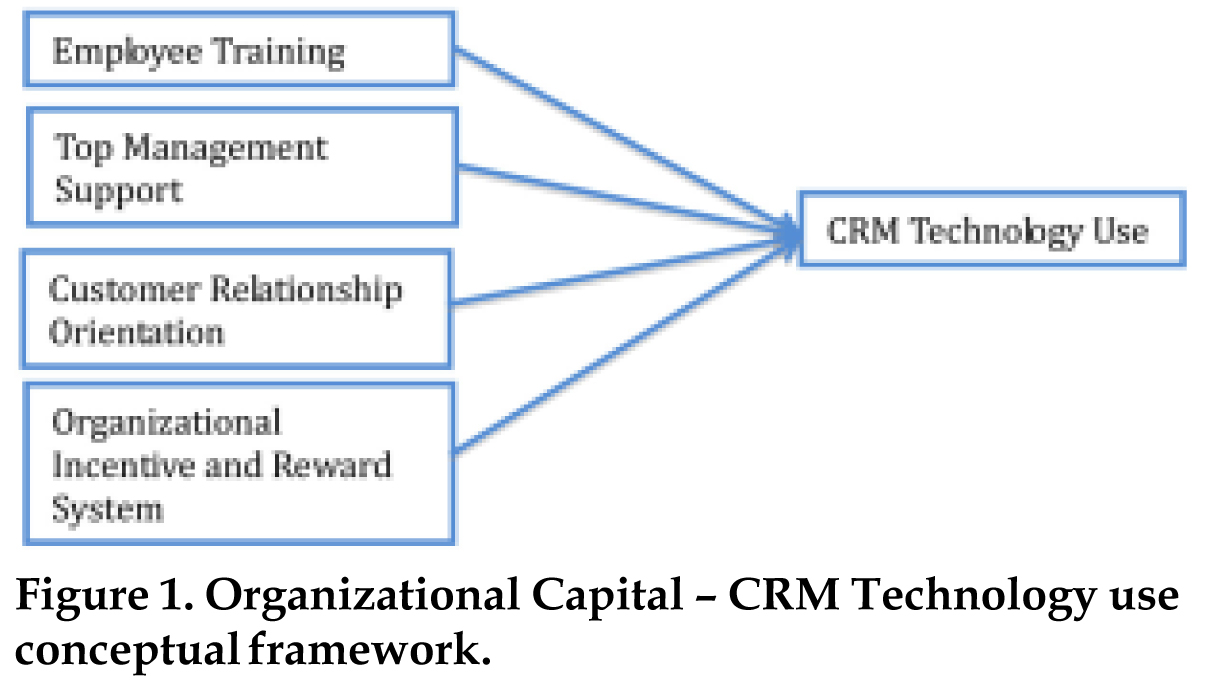
Methods
DataThe data was collected from sales and marketing managers of 155 firms from pharmaceutical industry with the help of self administered questaionnaire. The list of companies was obatained from BSE (Bombay Stock Exchange) official website. The list includes a combination of both top and low level companies in terms of market share.
Measures
Organizational CapitalOrganizational Capital construct was measured by 10 item scale, which includes its three subdimensions i.e., Employee training, Customer Centric Management system, and Customer Relationship Orientation (John, 2017).
CRM Technology use
In order to measure the CRM technology use, an index
originally developed by Jayachanderan et.al., 2005 was
used. The index was initially refined with the help of
Confirmatory Factor Analysis. The results of the
measurement model are presented in table 1.
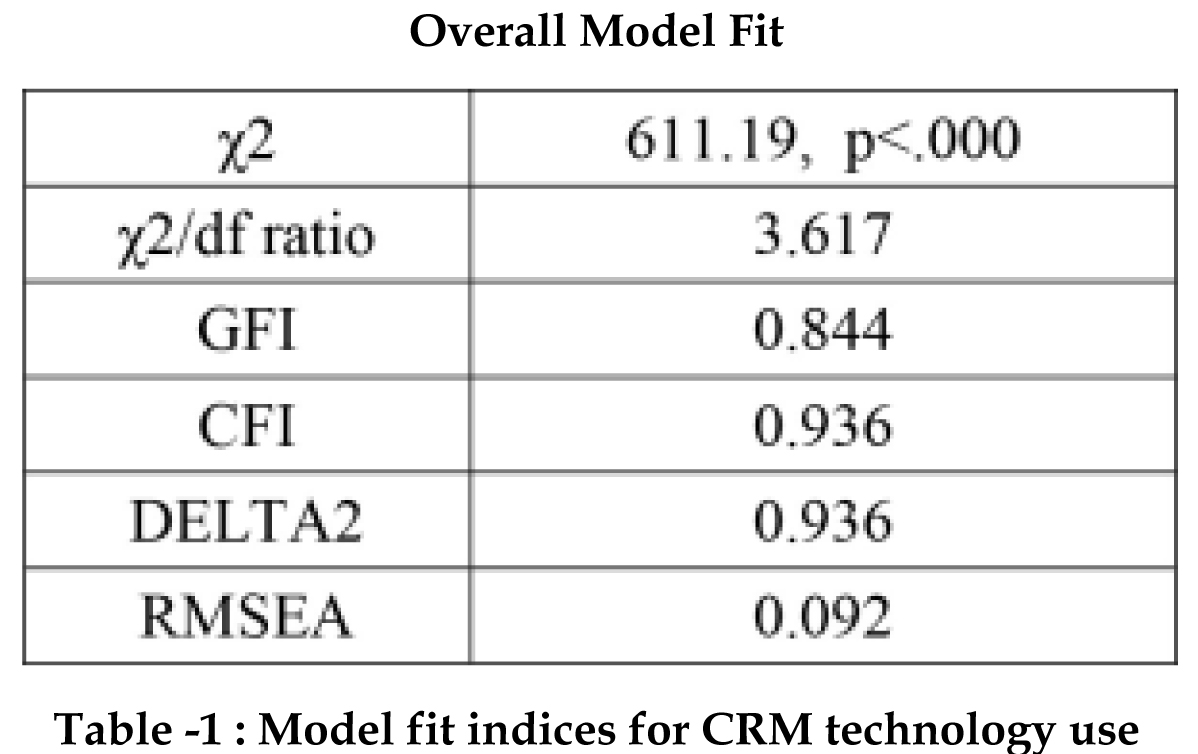
The ideal ÷2/df ratio lies between 1-5, whereas GFI values
approaching .9 indicate a good fit. Similarly the CFI value
in this particular model is well above the cut off level of .9
indicating a good fit. Looking at the different model fit
indices in table above it can be inferred that a three factor
model of CRM technology use best fits the data.
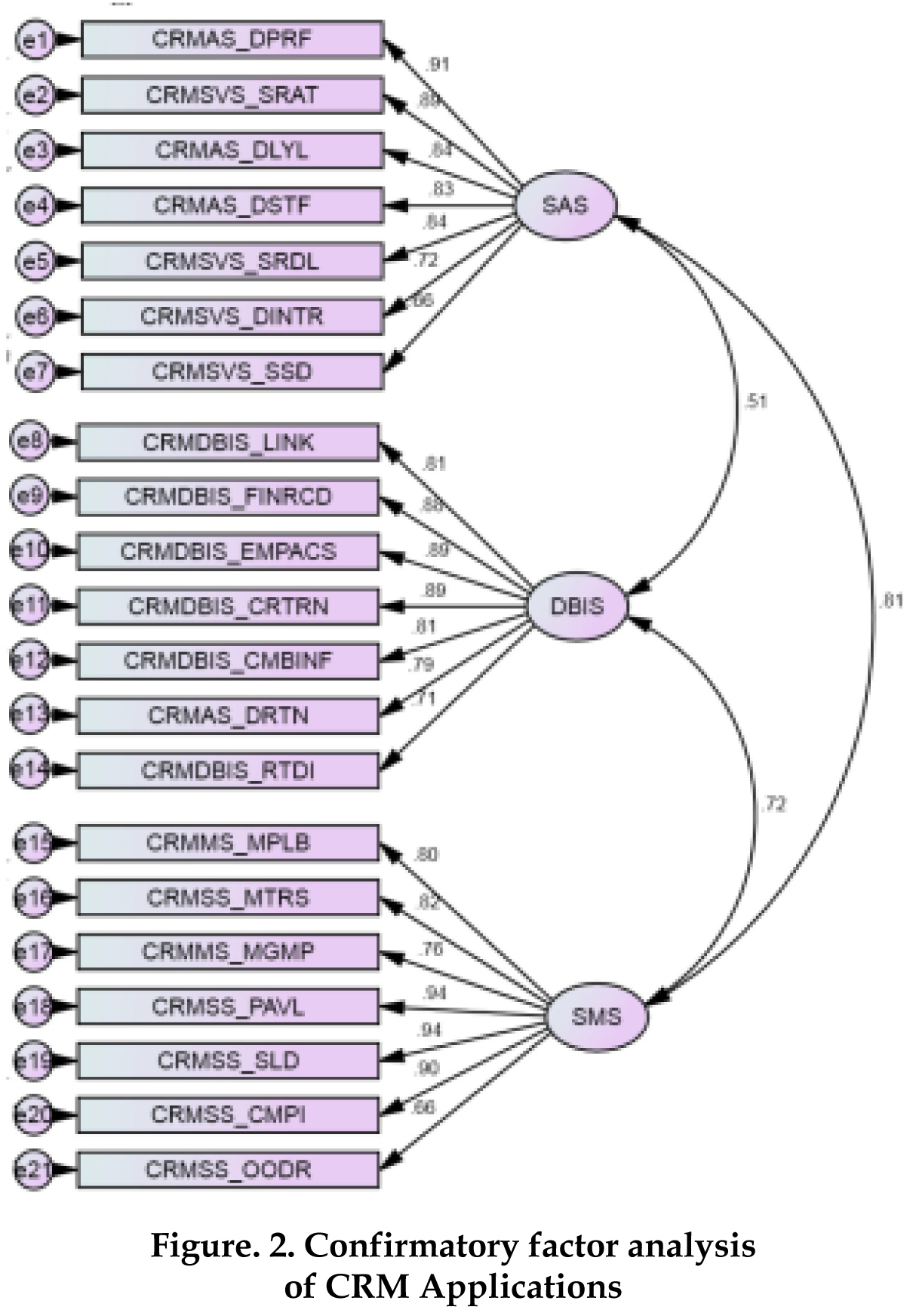
Path Analysis
Organizational Capital-CRM Technology use Structural model
First structural model was run on constructs of
Organizational Capital and CRM technology use in order
to assess whether higher deployment of Organizational
Capital leads to the subsequent higher use of CRM
Applications. In line with the suggestions of Anderson and
Gerbing (1988), the model fit indices of the model were also
checked for in order to determine the overall fit of the
structural model. The model fit indices of the
Organizational Capital-CRM Technology use structural
model indicate that it is a sufficiently good fitting model.
The model fit indices of the OC-CRMA structural model
are presented in table 6.19. Figure 6.12 presents the overall
model path structure. This initial structural model
consisted of second-order constructs and has been labelled
as OC-CRMA model A.
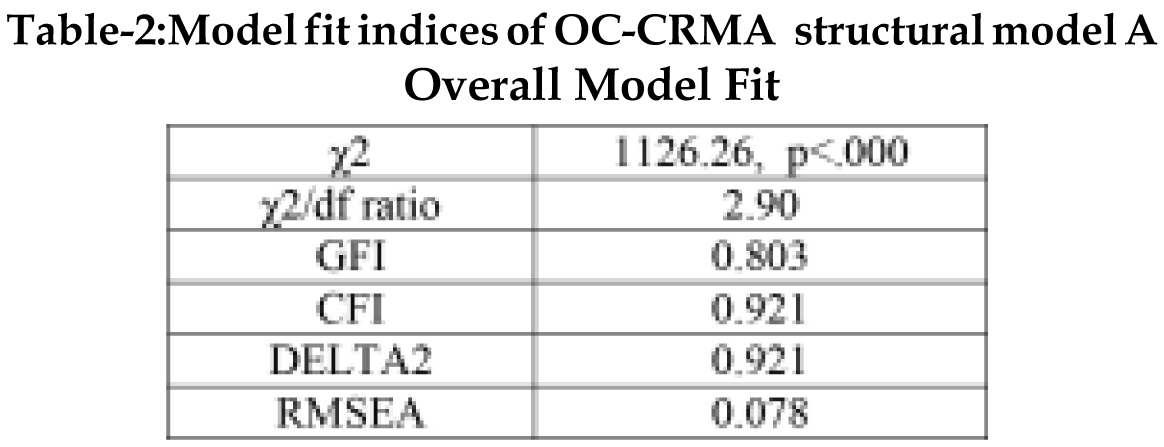
On examination of the regression path from
Organizational Capital to the CRM Technology use
construct, it can be seen that there is a very strong and
significant impact of the Organizational Capital on the
CRM Applications. The standardized estimate or
standardized regression coefficient between these two
constructs is 0.828. Moreover, looking at the standard
multiple correlation coefficient/ coefficient of
determination (R2) it can be seen that it is as high as 0.69
suggesting that Organizational Capital on Capital explains
69 per cent of the variation in the CRM Technology use
variable. The results of the path analysis are presented in
table 6.20.
 The results of this structural model analysis clearly suggest that Organizational Capital has a strong and significant
relationship with the use of CRM Applications. Thus, the first major hypothesis (H1) of this study is supported.
The results of this structural model analysis clearly suggest that Organizational Capital has a strong and significant
relationship with the use of CRM Applications. Thus, the first major hypothesis (H1) of this study is supported.
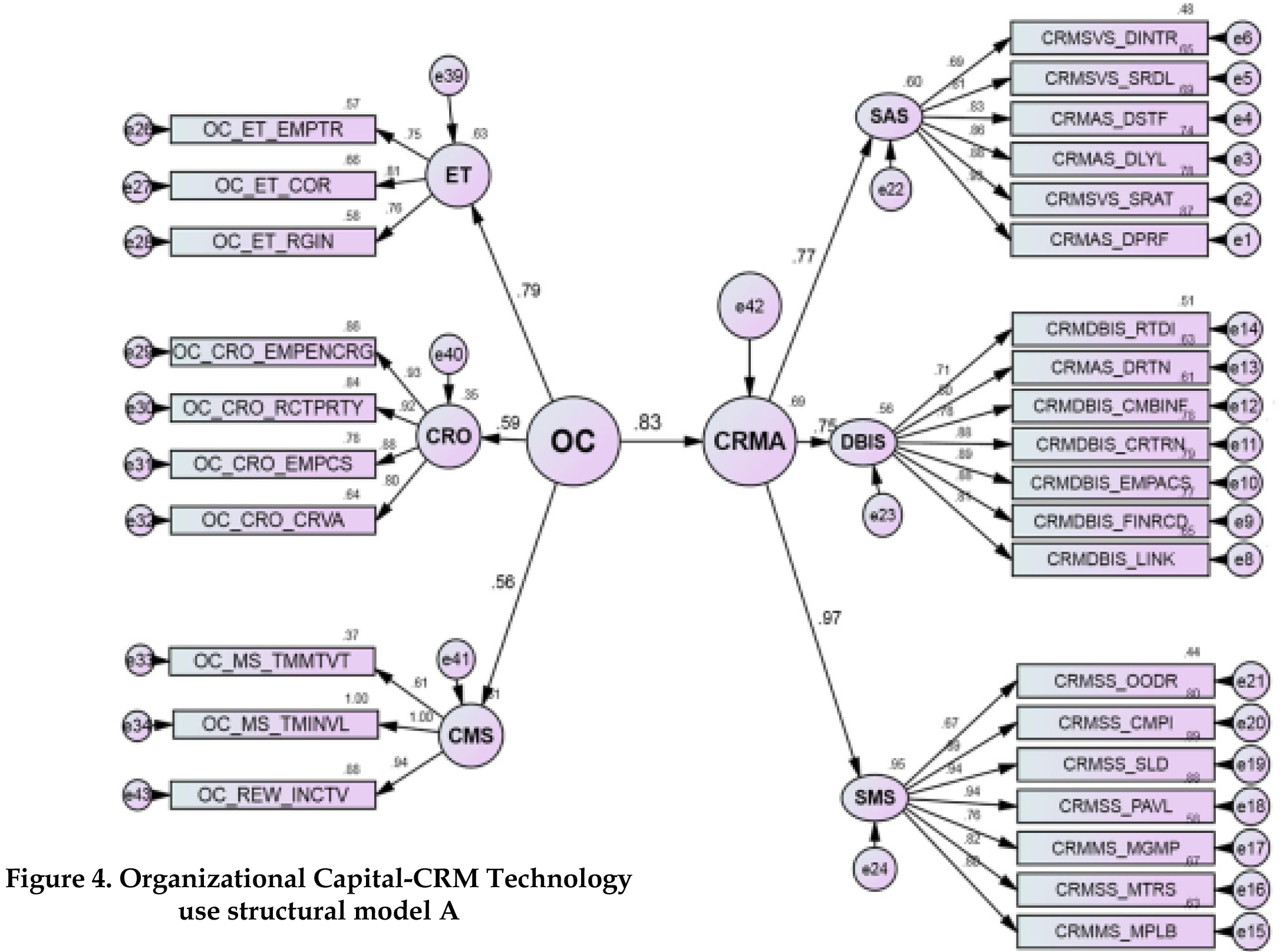
3.3.2. Revision and testing of sub-hypothesis
In order to check the impact of the individual dimensions of Organizational Capitali.e. Employee training (ET), Customer centric management system (CMS), and Customer Relationship Orientation (CRO) on CRM Technology use the first structural model was revised and Organizational Capital dimensions were incorporated in the in their first-order nature whereas the CRM Technology use construct was retained in its second-order form in order to simplify the interpretation of the results and avoid unnecessary complexity in the model. This model was labelled as OC-CRMA structural model B. Fit indices of the model are presented in the table 4.

Table 4 Model fit indices of OC-CRMA structural model B Overall Model Fit

The results of this model indicate that there is not much change in the values as for as the fit indices are concerned and the model exhibited a suitable fit like its earlier version. The model shows that all the three paths between three dimensions of Organizational Capital and CRM Technology use construct are significant with positive standardized regression coefficients indicating that all of them positively predict the use of CRM Applications. Among the three dimensions Employee training turned out to be the strongest predictors of the CRM Technology use with an estimate of almost .40, whereas Customer relationship orientation and Customer centric management system fell second and third in the order with estimates of .29 and .19 respectively. Thus it can be seen that all three components of Organizational Capital predict the use CRM Technology use in an organization and are equally important. However, the Employee training is the most important dimension among the three. Another important result obtained from these two structural models is that both the models behaved suitably well in their first order and second order nature. The overall results of the model are presented in table 6.22.
 Note : S.E= Standard error of estimate, C.R. = Critical ratio
Note : S.E= Standard error of estimate, C.R. = Critical ratio
Findings and Conclusion
The results from the first structural model clearly indicated that all the three components of Organizational Capital i.e., Customer centric management system, Customer Relationship Orientation and Employee training together are strong predictors of higher use of CRM Technology use within an organization. This suggests that Organizational Capital is the essential organizational transformation, which predicts the use of CRM technology in an organization. It also shows that a firm should work on all three components of Organizational Capital simultaneously if it intends to encourage its employees to use the CRM Technology use and also make the overall CRM technology work with greater benefits. These results are in line with the previous research which suggest that customer oriented organizations are more likely use CRM technology on a higher end and benefit from it consequently (Chang, Park & Chaiy, 2009; Day, 2003). These results show that while organizations try to make the CRM implementations a success, all three factors need to be managed equally. The organizations need to foster a culture that recognizes customer relationships as valuable assets. As expected, the results also indicated that Employee training was the strongest predictor of use of CRM Technology use and its role in successful implementation and use of CRM is quite evident. Thus, apart from these intangible resources the organizations also need make some investments in training the employees so that the CRM related tasks can be understood and performed by the employees in a smooth manner. Developing incentive schemes to attract the customer relationships will keep the employees motivated to be engaged in CRM programs.
Limitations and directions for future research
This study provides some useful insights despite some limitations. One of the limitations is that the data has been taken from Indian pharmaceutical industry. The future researchers may include samples from various industries in order to generalize the results. Further, some more factors may be included in the Organizational capital construct as the research related to this construct is very sparse. The CRM tehnology as such has evolved a lot during last few years and therefore CRM technology use index used in this study may not be a comprehensive index in terms of functionality aspects of CRM. The future research may focus on making this index more comprehensive and complete in order to measure the actual picture of CRM technoogy in an organization at a particular point in time.
References
- Anderson, J. C., & Gerbing, D. W. (1988). Structural Equation Modeling in Practice: A Review and Recommended Two-Step Approach. Psychological Bulletin, 103(3), 411-423.
- Boulding, W., Staelin, R., Ehret, M., & Johnston, W. (2005). A customer relationship management roadmap: What is known, potential pitfalls, and where to go. Journal of Marketing, 69(4), 155-166.
- Chang, W., Park, J. E., & Chaiy, S. (2010). How does CRM technology transform into organizational performance? A mediating role of marketing capability. Journal of Business Research, 63(8), 849-855.
- Day, G.S. (2003). Creating a Superior Customer- Relating Capability. MIT Sloan Management Review, 44(3), 77-82.
- Hunter, G. K., & Perreault, W.D. (2007). Making Sales Technology Effective. Journal of Marketing, 71(1), 16-34.
- Jayachandran, S., Sharma, S., Kaufman, P., & Raman, P. (2005). The role of relational information processes and technology use in customer relationship management. Journal of Marketing, 69(4), 177-192.
- John, W. (2017). Measuring Organizational Capital in CRM context : An EFA Approach. FIIB Business Review, 6(4), 39-47.
- ·Payne, A., & Frow, P. (2005). A strategic framework for customer relationship management. Journal of Marketing, 69(4), 167-176.
- Ryals, L., & Knox, S. (2001). Cross-functional issues in the implementation of relationship marketing through customer relationship management. European Management Journal, 19(5), 534-542.
